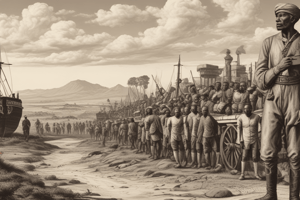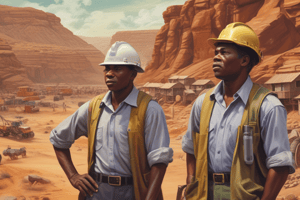Podcast
Questions and Answers
What were the three main requirements for diggers to excavate deep deposits of diamonds?
What were the three main requirements for diggers to excavate deep deposits of diamonds?
Machinery (particularly steam engines), credit, and a large labour force
Who took over the diamond mines quickly due to their access to credit, machinery, and labour?
Who took over the diamond mines quickly due to their access to credit, machinery, and labour?
The 'mining capitalists' - large corporations
What triggered a gold rush in 1886, leading to a similar pattern as seen in Kimberley?
What triggered a gold rush in 1886, leading to a similar pattern as seen in Kimberley?
The discovery of gold at the Witwatersrand orefields
Which companies bought up land at the Rand orefields after the gold discovery?
Which companies bought up land at the Rand orefields after the gold discovery?
What was the primary objective of the mining corporations and the colonial government regarding labour force?
What was the primary objective of the mining corporations and the colonial government regarding labour force?
Why did the corporations offer very low wages to workers at Kimberley and the Rand?
Why did the corporations offer very low wages to workers at Kimberley and the Rand?
What is the Mineral Revolution?
What is the Mineral Revolution?
What were the main drivers of the Mineral Revolution?
What were the main drivers of the Mineral Revolution?
How did the Mineral Revolution impact race relations in South Africa?
How did the Mineral Revolution impact race relations in South Africa?
What were the key discoveries that sparked the Mineral Revolution?
What were the key discoveries that sparked the Mineral Revolution?
How did the Mineral Revolution impact South Africa's economy?
How did the Mineral Revolution impact South Africa's economy?
When did the Mineral Revolution begin?
When did the Mineral Revolution begin?
Flashcards are hidden until you start studying
Study Notes
The Mineral Revolution
- The Mineral Revolution was a period of rapid industrialization and economic change in South Africa from the 1860s onwards.
- It was driven by the need to create a permanent workforce to work in the mining industry.
Causes of the Mineral Revolution
- The discovery of diamonds in Kimberley in 1867.
- The discovery of gold in Witwatersrand in 1886.
Impact of the Mineral Revolution
- Transformed South Africa from a patchwork of agrarian states to a unified, industrial nation.
- Had a significant impact on diplomacy and military affairs.
- Had an increasingly negative impact on race relations in South Africa, forming the basis of the apartheid system.
Diamond Mining
- Began with the discovery of diamonds at Kimberley in 1867.
- Led to a rush of prospectors, causing the population of Kimberley to skyrocket.
- As surface deposits of diamonds were excavated, deeper pits had to be dug, propelling the Mineral Revolution into a new phase.
- Required machinery, credit, and a large labour force, leading to the takeover of mines by "mining capitalists" (large corporations).
Gold Mining
- Triggered by the discovery of gold at the Witwatersrand orefields in 1886.
- Led to a gold rush, escalating the trend of industrial-scale mining.
- The orefields were quickly excavated of all surface deposits, and a similar pattern to Kimberley emerged, with small diggers being bought out by large corporations.
Demographic Shifts
- Forced major demographic shifts in South Africa's population.
- Labour was initially provided by young men from the African states, primarily Pedi men.
- The need to create a fixed, permanent labour force at Kimberley and on the Rand became the primary objective of the mining corporations and the colonial government.
Labour Issues
- The initial system of labour provision was too unreliable to provide a permanent labour force.
- Workers were often exhausted from their journey and had to be given two weeks' rest, at company expense, before they were fit to work in the mines.
- Workers who were not paid on time or did not like their living conditions tended to drift away, and workers were at risk of being recalled to their own countries.
Studying That Suits You
Use AI to generate personalized quizzes and flashcards to suit your learning preferences.




